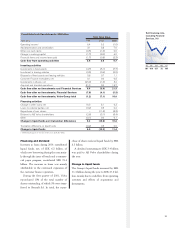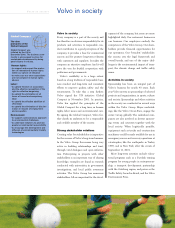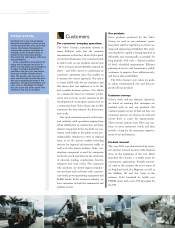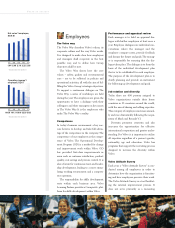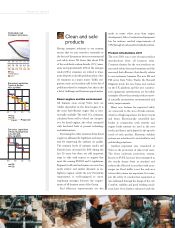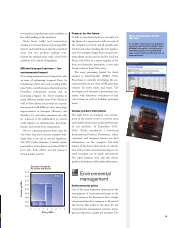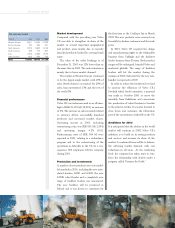Volvo 2001 Annual Report Download - page 35
Download and view the complete annual report
Please find page 35 of the 2001 Volvo annual report below. You can navigate through the pages in the report by either clicking on the pages listed below, or by using the keyword search tool below to find specific information within the annual report.
31
Risk policies
Volvo is exposed to various types of financial
risks. Groupwide policies form the basis for
each Volvo company’s action program.
Monitoring and control is conducted contin-
uously in each company as well as centrally.
Most of the Volvo Group’s financial transac-
tions are carried out through Volvo’s in-
house bank, Volvo Treasury, which conducts
its operations within established risk man-
dates and limits. Risk related to residual
values are managed by the different business
areas.
Currency risk
Volvo’s future flows of payments, loans and
investments, and the translation of assets and
liabilities in foreign subsidiaries are subject
to currency risks related to changes in for-
eign exchange rates. Volvo’s objective is to
minimize the short-term impact of adverse
exchange rate fluctuations on the operating
income, by hedging future transactions.
The objective is also to reduce the
Group’s balance sheet exposure to a mini-
mum. Volvo Group companies individually
should not assume any currency risk.
Credit risk
The credit risk in customer financing is dis-
tributed among a large number of individual
customers and dealers. Collateral is provided
in the form of the products being financed.
When issuing credit, an effort is made to
balance risk exposure and expected yield.
Operations are governed by common poli-
cies for credits and by rules for classifying
customers. The credit portfolio is distributed
properly among different categories of cus-
tomers and different industries. Credit risks
are managed through active monitoring and
follow-up routines and, in appropriate cases,
procedures for repossessing products.
Allocations are also made to credit-risk
reserves.
Residual-value risk
Residual-value risk is attributable primarily
to contracts involving operational leasing. It
comprises the risk that the leasing object, at
the end of the operational leasing contract,
has another residual value than foreseen
when the contract was entered. This may
force the lessor to dispose of products at a
loss. Residual-value risks are managed within
Volvo’s business areas through solid know-
ledge of the market, knowledge of product
and price trends, and programs supporting
the value of second-hand products. It is
Volvo’s policy to provide for this exposure
on a continuing basis, so that the book value
of these vehicles are in line with current and
anticipated future price levels on used com-
mercial vehicles.
During 2001, Volvo has increased its pro-
visions for residual value risks as a conse-
quence of declining used truck prices, pri-
marily in the US.
Interest-rate and liquidity risk
in customer financing
Changes in interest rates during the period
covered by a contract can affect income.
Therefore the policy is to match the fixed-
interest rate periods for borrowing and lend-
ing.
In a corresponding manner, the maturity
of the borrowing shall correlate with the
maturity of the outstanding contract. The
policy is to have a minimum liquidity
matching ratio of 80% for the customer
finance portfolio.
Financial risk management


